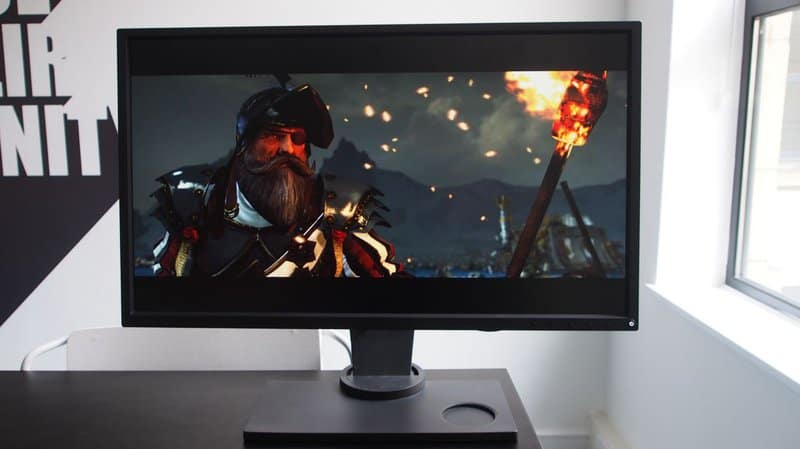PC gaming really is an experience unlike any other. In today’s PC games, you can do and see stuff that you never even dreamed possible – bringing you into a whole new world. And now, with all the great games in the pipeline for 2018, you should consider picking up one of the best gaming monitors to elevate these experiences to the next level. Honestly, why would you do the best PC games the disservice of playing on any old monitor?
You may be wondering what exactly separates the best gaming monitors from the rest, and the answer is ultimately going to boil down to taste. There is a plethora of features that the best monitors offer, and the features that you are actually going to use are going to change depending on the games you play. If you’re a competitive Counter Strike player, you’ll need a monitor that offers low latency and a high refresh rate. On the other hand, if you prefer games you can kick back and enjoy on your own terms, a 4K Ultra-HD gaming monitor might be right up your alley.
Admittedly, this is a bit much to take in, but don’t fret, we here on the TechRadar editorial team have you covered. This list is jam-packed with all of the best gaming monitors you’ll find in 2018. And, as an added bonus, every monitor on this list has been exhaustively tested by us here in-house, so you know that they’ll be worth your money. So, whatever kind of panel you’re looking for, no matter what kind of games you want to play – or how you want to play them, we’re confident you’ll find the best gaming monitor for you.
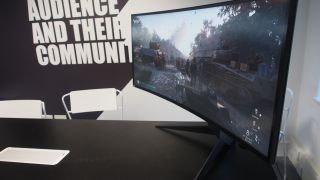
1. Alienware AW3418DW
The fastest ultrawide yet
Screen size: 34-inch | Aspect ratio: 21:9 | Resolution: 3,440 x 1,440 | Brightness: 300 cd/m2 | Response time: 4ms | Viewing angle: 178/178 | Contrast ratio: 1,000:1 | Color support: sRGB 100% | Weight: 26 pounds
Highest refresh rate in an ultrawide
Alienware design and build quality
Expensive
Takes up a lot of space
There has never been an ultra-wide monitor that can simultaneously give you the unparalleled immersion that a 21:9 resolution affords, while also delivering a high refresh rate that’s competitive with some of the best gaming monitors. Until now. Alienware has always had a reputation for delivering quality high-end equipment (at an equally high price point), and the Alienware AW3418DW is no exception. This monitor delivers a beautiful and colorful 21:9 display that will just suck you into whatever game you’re playing, and it does this while offering a lightning-fast 4ms response time and a stunning 120Hz refresh rate – making the AW3418DW truly the best of both worlds. However, all of these amazing features come with a premium price, and if you’re looking to save a few bucks, this might not be the best choice – regardless, it is the best gaming monitor you can buy today.
Read the full review: Alienware AW3418DW

2. AOC Agon AG352UCG
A curvy ultrawide that even has G-Sync
Screen size: 35-inch | Aspect ratio: 21:9 | Resolution: 3,440 x 1,440 | Brightness: 300 cd/m2 | Response time: 4ms | Viewing angle: 172/178 | Contrast ratio: 2,000:1 | Color support: sRGB 100% | Weight: 26 pounds
Curved 21:9 screen
G-Sync compatibility
It really is very big
Pricey
The Agon AG352UCG from AOC is a 21:9 AMVA panel that boasts a stellar 3,440 x 1,440 resolution and features G-Sync capabilities, solidifying it once and for all as the best gaming monitor in 2017. This means when paired with an Nvidia graphics card, this monitor uses G-Sync to eliminate screen tearing without adding stress to your PC hardware. What’s more, you can expect better response times from the AOC Agon than its closest competitors, meaning less input lag in titles like Overwatch or Lawbreakers that rely on faster pacing. The only catches are that the AOC Agon is kind of large and a bit expensive as well. Coming in at 26 pounds (11.8kg) total, you’ll want to be sure your desk can support it.
Read the full review: AOC Agon AG352UCG
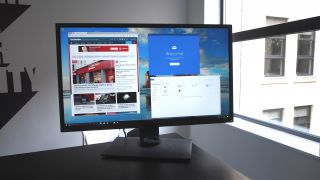
3. BenQ PD3200U
A large 4K screen for your desk
Screen Size: 32-inch | Aspect Ratio: 16:9 | Resolution: 3,840 x 2,160 | Brightness: 350 cd/m2 | Response Time: 4ms | Viewing Angle: 178/178 | Contrast Ratio: 1,000:1 | Color Support: sRGB 100% | Weight: 19 lbs
4K UHD resolution
Large Screen
Inexpensive relatively
Design is a little bland
Professional tools are niche
Takes up a lot of space
The BenQ PD3200U may be mainly aimed at business and CAD professionals, but that doesn’t mean it doesn’t have anything to offer people who want one of the best gaming monitors. Because of its focus on graphic design and business, it’s able to offer simply amazing viewing angles, meaning that no matter where you’re sitting, or where your spectators are, you’ll be able to get immersed in the action. Plus, unlike many 4K monitors, you don’t have to mess around with the settings in order to get the best picture possible –
every single unit is individually calibrated and prepared by BenQ before it’s shipped. All of this culminates in the fact that at under 800 bucks for a 32-inch 4K monitor, it’s one of the most inexpensive ways to get into 4K gaming without sacrificing utility to a smaller 4K display.
Read the full review: BenQ PD3200U
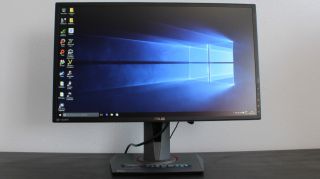
4. Asus MG248Q
A budget monitor with 144Hz and Adaptive Sync
Screen size: 23.6-inch | Aspect ratio: 16:9 | Resolution: 1,920 x 1,080 | Brightness: 350 cd/m2 | Response time: 1ms | Viewing angle: 170/160 | Contrast ratio: 1 million:1 | Color support: SRGB 100%, Adobe RGB 72% | Weight: 16.98 pounds
144Hz refresh rate
1ms response time
TN panel
Adaptive Sync for AMD, Intel only
If you’re looking for a budget gaming monitor, and don’t mind making a few compromises (it features a 1080p resolution and twisted-nematic, or TN, panel rather than IPS), then you’ll be very pleased with the Asus MG248Q. It makes up for any shortcomings with lightning fast response times and Adaptive Sync, making this the best budget gaming monitor in 2018. Adaptive Sync is of interest to gamers, as it reduces screen tearing if you have an AMD graphics card, a clear demonstration that the MG248Q tailors to the budget gamer. On the other hand, even Nvidia fans can rejoice at the 144Hz refresh rate. But, without the right GPU equipped, you might be better off saving for the G-Sync equivalent Asus ROG Swift PG248Q.
Read the full review: Asus MG248Q
- This product is only available in the US and Australia as of this writing. UK readers: check out a fine alternative in the Asus ROG Swift PG248Q
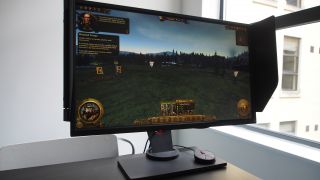
5. BenQ Zowie XL2540
A monitor tailored to the needs of professional gamers
Screen size: 24-inch | Aspect ratio: 16:9 | Resolution: 1,920 x 1,080 | Brightness: 400 cd/m2 | Response time: 1ms | Viewing angle: 170/160 | Contrast ratio: 1,000:1 | Color support: NTSC 72% | Weight: 7.5kg
High refresh rates
Easy setup
Expensive
Limited appeal beyond pro gamers
You might not believe it at first glance, but the BenQ Zowie XL2540 is every bit the gaming monitor that the other monitors on this list are. And though it may not seem it from the outside looking in, it does its job remarkably well too, sacrificing dazzling lighting effects for a zippy 240Hz refresh rate and nigh-instantaneous 1ms response time. There’s no G-Sync or FreeSync, as this monitor assumes you already have a rig that’s plenty capable of eliminating screen tears on its own. Instead, this monitor keeps it simple by supplying you with lots of visual presets, an “S Switch” control pod for managing those presets and even a pair of adjustable light screens. If you’re a professional gamer, then this is the best gaming monitor for you.
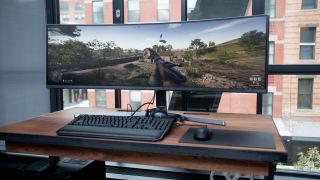
6. Samsung CHG90 QLED
Screen Size: 49-inch | Aspect Ratio: 32:9 | Resolution: 3,840 x 1080 | Viewing Angle: 178/178 | Contrast Ratio: 3,000:1 | Color Support: N/A | Weight: 33 lbs
Flawless image quality
Impressive Color reproduction
Smooth 144Hz refresh rate
Expensive
Only 1080p vertically
With this display, Samsung not only brings QLED to gaming monitors in a big way, but they also offer the widest ultra-wide monitor on the market today. Coming in at 49.5 inches, this behemoth will take up a lot of space, likely peeping over the sides of your desk, but with its impressive 3,840 x 1080 resolution and HDR, you’ll at least be blown away by the image. Even if you decide not to play in this resolution (it will require a beefy rig), you can still use all of the extra screen real estate to have a browser or a movie playing on the same screen. The only real drawback is the monstrous price tag. But for a display this premium, it may very well be worth it.
Read the full review: Samsung CHG90 QLED
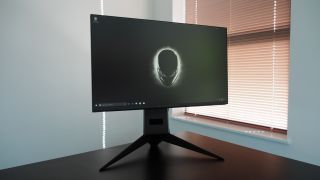
7. Alienware 25
FreeSync, G-Sync and everything in between
Screen size: 24.5-inch | Aspect ratio: 16:9 | Resolution: 1,920 x 1,080 | Brightness: 400 cd/m2 | Response time: 1ms | Viewing angle: 170/160 | Contrast ratio: 1000:1 | Color support: SRGB 119% | Weight: 11.7kg
Great design
High refresh rate
Expensive
Only 1080p
The coolest thing you can say about the Alienware 25 gaming monitor is that it won’t discriminate against your PC. Although it’s often the case that gaming monitors support Nvidia G-Sync or AMD FreeSync, not both, to eliminate screen tearing, the Alienware 25 can be configured either way. That comes in handy, even if it’s more expensive for the Nvidia model. Still, the Alienware 25 isn’t entirely function over form. Instead, it boasts a strikingly exotic design, complete with the AlienFX RGB lighting we’ve all come to expect from the Dell subsidiary. And if that’s not enough to sell you on the Alienware 25, it wields a buttery smooth 240Hz refresh rate that will push any stout rig to its limits.

8. Asus ROG Swift PG248Q
Faster than you can say G-Sync
Screen size: 24-inch | Aspect ratio: 16:9 | Resolution: 1,920 x 1,080 | Brightness: 350 cd/m2 | Response time: 1ms | Viewing angle: 170/160 | Contrast ratio: 1,000:1 | Colour support: Adobe RGB 74% | Weight: 9.5kg
Cheapest G-Sync display on the market
Amazing 180Hz refresh rate
Just two display inputs
Only 24 inches
If you care more about frame rate than graphics or resolution, this one’s for you. Because of its very impressive 180Hz refresh rate, the Asus ROG Swift PG248Q takes the 60fps gold standard for gaming and triples it – provided you’re equipped with a rig that can handle the extra stress. While you’re unlikely to enjoy Forza Horizon 3 at 180fps on Ultra settings given its high demand, a higher refresh rate is more than welcome in fast-paced, competitive games that don’t necessarily depend on a wealth of resources. Plus, as one of the most affordable G-Sync displays on the market, it helps that you can rely on the monitor to prevent screen tearing, too.
Read the full review: Asus ROG Swift PG248Q
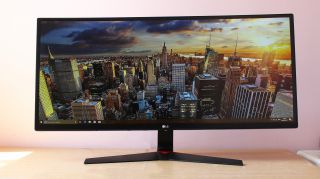
9. LG 34UC79G-B
A reasonable entryway to ultra wide and FreeSync
Screen size: 34-inch | Aspect ratio: 21:9 | Resolution: 2,560 x 1,080 | Brightness: 250 cd/m2 | Response time: 10.3ms | Viewing angle: 178/178 | Contrast ratio: 1,000:1 | Color support: sRGB 92.1% | Weight: 8.6kg
Curved 21:9 screen design
AMD FreeSync
Lesser resolution than rivals
Ineffective gaming modes
If you’re running games using AMD- or Intel-based graphics and want to get into ultra wide displays without spending a fortune, this is the gaming monitor to look out for. At 34 inches diagonally, the LG 34UC79G-B is equipped with AMD FreeSync for screen tear elimination and a 21:9 aspect ratio best suited for games and cinema. Despite the resolution being lower than a lot of other widescreen displays on the market, there’s no denying that the LG 34UC79G-B pulls off a crisp image nonetheless – and with stunning color accuracy at that. Plus, you can change the height, which is more than can be said for even some of the pricier 4K monitors available today.
Read the full review: LG 34UC79G-B
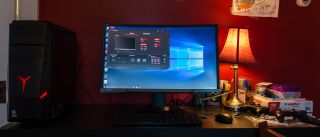
10. Lenovo Y27G Curved Monitor
A lovely-designed curved monitor
Screen size: 27-inch | Aspect ratio: 16:9 | Resolution: 1,920 x 1,080 | Brightness: 300 cd/m2 | Response time: 7ms | Viewing angle: 178/178 | Contrast ratio: 3,000:1 | Weight: 6.75kg
Large screen
High resolution
No DVI
Lack of extra features
The Lenovo Y27G is a gaming monitor that includes a curved screen with its regular 16:9 aspect ratio, which gives you some added immersion while you’re playing. The 1080p resolution is a little on the low side, but it does mean there’s less strain on your graphics card, making this an excellent gaming monitor for people who don’t have the budget to buy the latest and greatest GPUs. It also means that, with the relatively low resolution, your GPU can concentrate on pushing high frame rates, with the Lenovo Y27G coming with a 144hz refresh rate and available with either Nvidia G-Sync or AMD FreeSync anti-screen tearing technology.
- This product is only available in the US and UK at the time of this writing. Australian readers: check out a fine alternative in the LG 34UC79G-B
How to buy the best gaming monitor in 2018
When you are shopping for the best gaming monitor 2018 has to offer, there are a few things that you should consider before you decide on what display should grace your desk.
By studying the following terms and specifications, you can make sure you pick the best gaming monitor for your needs – which also means you’re not paying extra for additional features that you don’t need.
Screen size: When shopping for the best gaming monitor, one of the most crucial things to think about is screen size. Larger display sizes can contribute to more immersive gaming experiences, as the game fills more of your field of vision, but you’ll need to make sure you have the room to feature a large monitor. It also goes without saying that larger monitors will usually mean a higher price.
Aspect ratio: The aspect ratio of a gaming monitor determines the width and height of the screen. Most widescreen monitors have an aspect ratio of 16:9, while older monitors had a more square 4:3, which will likely look pretty outdated in 2018. Ultra-wide monitors with aspect ratios of 21:9 are quickly gaining prevalence – they offer a wide view of your games, and many ultra wides have made our list of the best gaming monitor 2018.
Resolution: Another important factor when looking for the best gaming monitor for your needs is resolution. Here, the higher the numbers, the sharper the picture.. You will, however, need a more powerful graphics card for anything over full HD (1,920 x 1,080), even if many gaming monitors feature resolutions as high as 2,560 x 1,400 (WQHD) and 3,840 x 2,160 (4K).
Refresh rate: When you’re looking to primarily play Counter-Strike, or shooters like it, refresh rate is especially important. The higher the refresh rate, the more frames per second (fps) it can support, which lends to a smoother experience on high-refresh-rate displays. A 60Hz refresh rate is most common, with refresh rates rising to 144Hz and even 200Hz.
Response time: The best gaming monitors have low response times, which means the action remains fast and fluid, with little to no input lag. The lowest response time for TN monitors (we explain this in the next section) is 1 millisecond, whereas the newer IPS monitors usually have more delayed, 4ms response times. When you’re playing games competitively, it’s crucial to keep this number as low as possible in order to combat lag.
Panel type: This is where things get a little technical. The type of panel the gaming monitor uses will largely contribute to its response time and image clarity. TN panels (twisted nematic) have the lowest response times, and they are usually cheaper as well, but they generally don’t have great viewing angles. IPS panels (in-plane switching) have fantastic viewing angles and color reproduction, but usually higher response times. Meanwhile VA panels (vertical alignment) sit between the two, though the slow response times makes these panels rare amid the best gaming monitors.
Viewing Angle: Most people play games while positioned in front of their gaming monitor, but this may not always be the case, particularly when you’re among spectators. A monitor’s viewing angles tell you what angle you can look at the monitor from and still clearly make out the image. The closer these numbers are are to 180, the better your viewing experience will be when standing further to either side of the monitor or looking at it from above or below.
G-Sync and FreeSync: You’ll likely notice that many of the best gaming monitors in 2018 come with either G-Sync or FreeSync technology – sometimes both. This helps keep frames per second (fps) smooth, combats screen tearing and diminishes input lag. G-Sync is developed by Nvidia, so you’ll need an Nvidia GPU, and the tech is built into the monitor, which can bump up their price tag. Meanwhile FreeSync was developed by AMD but, as it is free to use by manufacturers, the monitors usually cost less.
Gabe Carey and Bill Thomas have also contributed to this article
- Looking for a more general monitor? Check out our list of the best monitors

